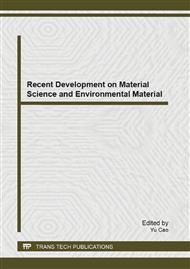[1]
A. Kraft, A.C. Grimsdale, A.B. Holmes, Electroluminescent conjugated polymers-seeing polymers in a new light, Angew. Chem. Int. Ed. 37 (1998) 402-428.
DOI: 10.1002/(sici)1521-3773(19980302)37:4<402::aid-anie402>3.0.co;2-9
Google Scholar
[2]
I.F. Perepichka, D.F. Perepichka, H. Meng, F. Wudl, Light-Emitting ploythiophenes, Adv. Mater. 17 (2005) 2281-2305.
DOI: 10.1002/adma.200500461
Google Scholar
[3]
R.J. Mortimer, A.L. Dyer, J.R. Reynolds, Electrochromic organic and polymeric materials for display applications, Displays 27 (2006) 2-18.
DOI: 10.1016/j.displa.2005.03.003
Google Scholar
[4]
J. Roncali, Molecular Engineering of the Band Gap of π-Conjugated Systems: Facing Technological Applications, Macromol. Rapid Commun. 28 (2007) 1761-1775.
DOI: 10.1002/marc.200700345
Google Scholar
[5]
F. Liesa, C. Ocampo, C. Aleman, E. Armelin, R. Oliver, F. Estrany, Application of electrochemically produced and oxidized poly(3, 4-ethylenedioxythiophene) as anticorrosive additive for paints: Influence of the doping level, J. Appl. Polym. Sci. 102 (2006).
DOI: 10.1002/app.23925
Google Scholar
[6]
C. Ocampo, E. Armelin, F. Liesa, C. Aleman, X. Ramis, J.I. Iribarren, Application of a polythiophene derivative as anticorrosive additive for paints, Prog. Org. Coat. 53 (2005) 217-224.
DOI: 10.1016/j.porgcoat.2005.02.009
Google Scholar
[7]
T. McQuade, A. Pullen, T. Swager, Conjugated Polymer-Based Chemical Sensors, Chem. Rev. 100 (2000) 2537-2574.
DOI: 10.1021/cr9801014
Google Scholar
[8]
L.Q. Qin, J.K. Xu, B.Y. Lu, Y. Lu, X.M. Duan, G.M. Nie, Synthesis and electrochromic properties of polyacrylate functionalized poly(3, 4-ethylenedioxythiophene) network films, J. Mater. Chem. 22 (2012) 18345-18353.
DOI: 10.1039/c2jm32457a
Google Scholar
[9]
S.M. Zhang, L.Q. Qin, B.Y. Lu, J.K. Xu, Low-potential electrosynthesis of novel electroactive poly(9-fluorenemethanol) and its electrochromic and blue-light-emitting properties, Electrochim Acta 90 (2013) 452-460.
DOI: 10.1016/j.electacta.2012.12.063
Google Scholar
[10]
C. Zhang, C. Hua, G.H. Wang, M. Ouyang, C. Ma, A novel multichromic copolymer via electrochemical copolymerization of (S)-1, 1'-binaphthyl-2, 2'-diyl bis(N-(6-hexanoic acid-1-yl) pyrrole) and 3, 4-ethylenedioxythiophene, Electrochimica Acta 55 (2010).
DOI: 10.1016/j.electacta.2010.02.086
Google Scholar
[11]
Z.H. Wei, J.K. Xu, S.Z. Pu, Y.K. Du, Electrosyntheses of High-Quality FreestandingPoly(fluorene-co-3-methylthiophene) Films with Tunable Fluorescence Properties, J. Polym. Sci. Pol. Chem. 44 (2006) 4904–4915.
DOI: 10.1002/pola.21572
Google Scholar


